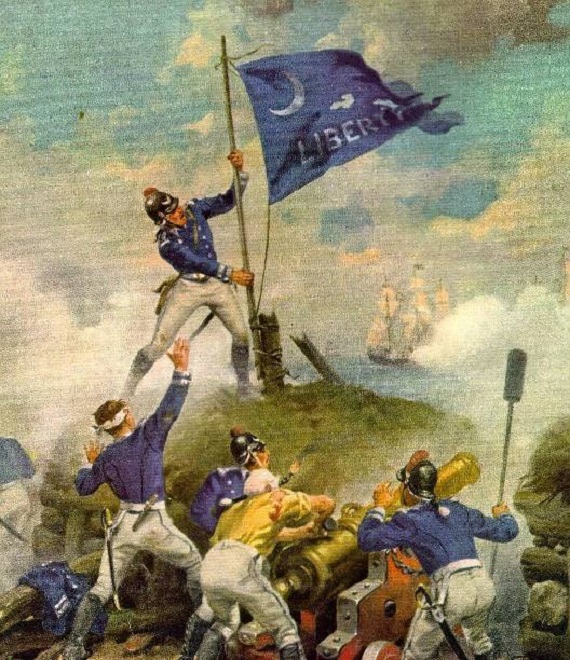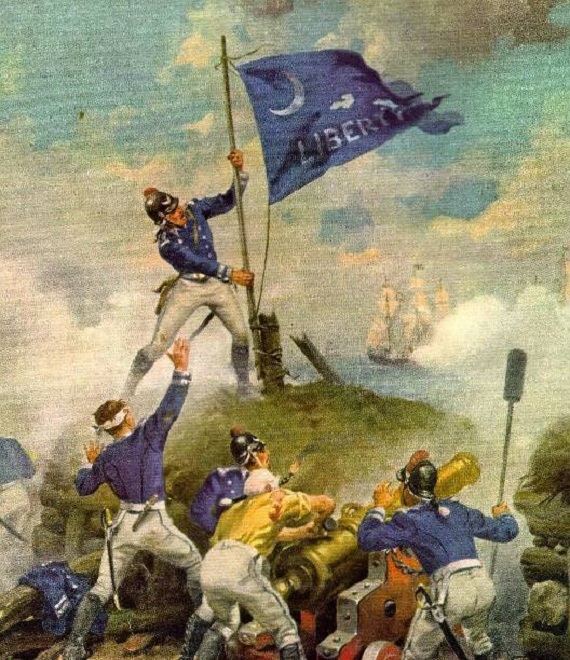A review of Nullification and Secession in Modern Constitutional Thought. Sanford Levinson, ed. Lawrence, KS: University of Kansas Press, 2016.
The undead walk among us still, or so asserts Sanford Levinson, the editor of an important collection of essays on nullification and secession. Levinson and company are as mainstream a group political scientists, law professors, and historians as one might wish for, and thus the importance of this collection. For decades, nay more than a century, the respectable members of the academy assured the public that such heresies as nullification and secession were long ago consigned to the dustbin of history, forever buried with the appropriate wooden stake through the heart via Lee’s surrender at Appomattox. Not so, say our contributors, and not just in these United States. It seems that the forces and proponents of political consolidation throughout the globe are meeting with resistance, non-cooperation, material nullification, and even secession. The contributors to this volume are to be commended for attempting to understand these phenomena, both historic and contemporary, with detachment and fairness, and all the more since it is clear few if any of the contributors have much sympathy with nullification, secession, or its modern day proponents. Furthermore, the essays contain many fine insights into some of the more problematic aspects of the American political order.
As a point of fairness allow me to offer a fair disclosure on where I stand concerning the American political order. My specific training as a historian leaves me a bit suspicious of theory, though I confess an occasional foray into the field as a guilty pleasure. Contingency, and its role in change and continuity, seem to me the more significant movers to me in politics and. For example, the Declaration of Independence becomes a mere curiosity in a failed provincial rebellion if the Maryland line makes the decision not cover the retreat of Washington’s forces at the battle of Long Island. The Philadelphia Convention may have receded into memory in the same fashion had the independent states taken action against their representatives at the Convention for gravely exceeding their authority. Whether we like it or not, what happened at Philadelphia was a bold act of regime change, and not one representative at that gathering could legally claim the authority from their state to engage in such a revolutionary act. Thus, we are left with the fact that the United States was not born of one revolutionary act but two. This is, in my humble view, crucial.
Regime change by its nature invites experiment (did not many of the framers refer to the new federal republic as such?) and instability. True, many conservative voices at the Philadelphia Convention won important victories in erecting at least paper barriers to federal consolidation, or like John Dickinson, calling the members to trust more in the received wisdom and experience of self-government the former colonies enjoyed for many seasons, than the metaphysical nostrums of some of the more “egg-headed” at the convention. Nevertheless, it should be rather a sobering thought that a mere seventy two years after the ink dried on the parchment, the grandsons of the framers of the Constitution were shooting each other down in the country’s bloodiest conflict to date. This may not be indicative of a failed state, but it is suggestive that there are important latent, and not so latent, sources of instability in the constitutional order of these United States.
So given my antifederalist tendencies and curmudgeonly outlook on these matters, I found it a pleasant surprise that many of the contributors to this volume recognized in the proponents of secession, interposition, and nullification sincere attempts to address the instabilities in the American political regime. Or to be clear, it is now in the pale of respectable scholarly discourse to view the unchecked centralization of power in the federal government as a threat to constitutional maintenance. Of course, one may argue that interposition, nullification, and secession also are credible threats to constitutional maintenance. Which raises the crucial question, “How is it that such diametrically opposed actions as the consolidation of power in the federal government, secession, nullification, and interposition can all be threats to the maintenance of the American constitutional order?”
Sanford Levinson provides a good starting place to tackle this question by asking a related question, “Is there a final authority at all? If so, who is it?” Ah, therein lay the rub. Those who might put forward the Supreme Court as that authority have some hurdles to clear. First, Article Three to the constitution never explicitly confers the power of judicial review upon the Supreme Court. Second, John Marshall, in the landmark case Marbury v. Madison, sneaks judicial review under the door. He never asserts the Supreme Court has this power, he just uses it. Third, Marshall may have used the power, but he never asserted in the decision that the Supreme Court had an exclusive authority to interpret the Constitution. Levinson also rightly criticizes what he calls the “Appomattox argument” and its proponents. This argument postulates that the Union victory in the War Between the States put to rest all debate concerning the legitimacy of secession and nullification. In my view, Levinson is correct for two reasons. Attempts at all sorts of practical nullification or interposition are bountiful in the post-war era: massive resistance in the South to forced public school integration, as well as more recent resistance to federal immigration law and narcotics laws at the state and local level. On a theoretical level, if one accepts that the consent of the governed is the foundation of political legitimacy, how is coercive military action directed at a politically conscious people, a people who define themselves as a separate political entity, a legitimate political act? One of the sillier answers to this question suggests that there was one definitive act of consent given by the “Founders” binding all progeny forever to the constitutional order of the Union. I have yet to find the document or contract detailing the particulars of this definitive act of consent, and I also recall that the Articles of Confederation were supposed to be “perpetual.” It seems “revolution” is a part of the American political DNA, so that political regimes in America are perpetual until they are not. Thus Levinson’s conclusion is apt, “one simply cannot understand American or world history without paying respectful attention to the reality of secession.” Let the Church say amen!
No collection of this sort is complete without a consideration of James Madison and his views on interposition. To Jonathan Gienapp the task fell, and he gives us a valuable insight into the mind of a political Rube Goldberg (my view, not Gienapp’s). As Gienapp points out, Madison was deeply concerned with how the American constitutional order might maintain itself through a crisis of overreach by a branch of the federal government or the entire federal government for that matter. Madison’s remedy was to turn to “the people,” who must be informed of the danger facing the republic and somehow activated to preserve the republic’s constitutional order. Gienapp, who does admire Madison, honestly assesses Madison’s remedy as insufficient. Madison is typically opaque on how the people are to be activated and what actions the people might undertake once they are activated. To be charitable, Madison probably knows that the road leads to some form of resistance against federal power, perhaps even revolution, and he did not wish to go there. Does this not prove the point that political regimes conceived in revolution may have particular difficulty with maintaining their constitutions?
James H. Read and Neal Allen contribute a piece that provides a historical overview of nullification and secession. Like Levinson’s contribution, Read and Allen ask important and fundamental questions. The most valuable question they ask is whether the United States exists as a “deliberate political community?” In my view, Read and Allen correctly assert that the answer to this question is to be found more in the practice of American politics, and not in the “parchment.” Here they echo, to a limited degree, John Randolph of Roanoke’s criticism of the Constitution’s “parchment barriers” and his advocacy of praxis by means of custom and tradition. While Read and Allen are not particularly favorable to “neo-nullification” advocates such as Tom Woods, yet Read’s and Allen’s emphasis on political praxis, as opposed to theory, suggests that Woods and his ilk may prove to be significant in terms of policy influence. If political trends continue to favor the resistance of the periphery (states and local communities) to the center (the federal government), then Woods and his ideas may exert real practical influence.
Other gems offered by the contributors include the following: Ernst Young’s insight that concurrent jurisdiction has replaced dual federalism, and thus opened up new ways of resisting federal for states and local governments by refusing cooperation with federal enforcement efforts. Given the dependence of the federal government upon the cooperation of state and local governments to implement and enforce federal edicts and policies, non-cooperation is an effective and important means of peripheral resistance to the central government. In a similar vein, Mark A. Graber identifies ways in which “partial nullification” and interposition do function as effective means of resisting federal law. For example, the Supreme Court’s view that jury verdicts cannot be impeached allows a good deal of room for jury nullification. Vicki Jackson also offers an important piece in her exploration of the global precedents of secession that exist. Ran Hirschl also strikes a blow against the view that secession and nullification are somehow American exceptions or aberrations. Indeed, he explores the uncomfortable truth for many globalists that “separatist impulses” are not going away, instead they may be gaining some momentum.
I must confess that I was a bit taken aback by the contribution of Jared Goldstein, whose main point seems to be that violent “private resistance” to perceived federal tyranny “flows naturally from the constitutional philosophy of the nullification movement.” For Goldstein, nullification seems to lead “naturally” to violent insurrection, as it is merely one of the first tactics to be employed by those people who seek to resist a perceived federal injustice. There may well be people out there who do believe this, and rightly Goldstein does name the names of those he thinks fit the bill, but I rather doubt that if one holds to the doctrine of nullification in some form or other, one is then ipso facto an advocate or potential advocate of violent insurrection. I suggest that at least some advocates of nullification today and yesterday, especially its most able theorist John C. Calhoun, viewed nullification as a way to defuse potential violent conflicts. I might also suggest that any latent American tendencies toward violent insurrection, be it of the left or the right, may well have deeper roots than the emergence of nullification. The roots I refer to are, of course, the American Revolution and the violent insurrectionary acts which preceded it.
Unfortunately, space does not permit me to do justice to all of the contributors. It is an important work though, and one which deserves a close and fair reading. Certainly, not all of the perspectives of the contributors are shared by the members and supporters of the Abbeville Institute, and there are some perspectives here that many of us might reject outright. Nevertheless, the contributors have done a fine job of giving serious attention to important centrifugal trends in the American and transnational political order, trends which may continue to strengthen and gather momentum in the years ahead.







